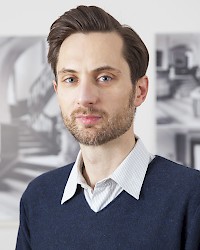Vita
Elie During is Associate Professor and Director of the master’s degree program in philosophy at Paris Nanterre University. He is a member of the IRePh research lab (Institut de Recherches Philosophiques, Paris Nanterre). He also teaches seminars at the European Graduate School (EGS) and the École nationale des Beaux-arts in Paris.
A former student from the École normale supérieure in Paris (1993-1998) and Princeton University (Procter fellowship, 1995-1996), he received a PhD from Paris Nanterre University on the philosophical interpretations of relativity theory (“From relativity to space-time: Bergson between Einstein and Poincaré”, 2007). In the following years, he contributed to several volumes of the critical edition of Henri Bergson’s works for the Presses universitaires de France. His current research focuses on the philosophical and cultural implications of notions of space-time and simultaneity at the crossroads of aesthetics, metaphysics and the philosophy of science.
He is a member of the editorial board of Critique (Éditions de Minuit), as well as a series editor of “MétaphysiqueS” (Presses universitaires de France) and “Idées” (Presses universitaires de Paris Nanterre).
Dated from 2018
Fields of research
French contemporary philosophy (since Bergson)
History and philosophy of science (relativity theory)
Philosophy of time (and space-time)
Aesthetics of contemporary arts (with a view to architecture and cinema)
IKKM Research Project
“Action at a distance” and the experience of simultaneity
“The biggest challenge to developing telepresence is achieving [the] sense of "being there"”, Minsky wrote in his seminal 1980 paper “Telepresence”. What about “being now”? How is the sense of simultaneity at a distance affected by the intensive use of telepresence technologies? This issue must be addressed at a fundamental level. The first point to be elucidated is the idea of tele-action in general. It is crucial to distinguish between remote action, which is generally understood in terms of a signal or piece of information being propagated from place to place across a communication medium, and action at a distance, which does not need to be instantaneous but incorporates an inherently trans-spatial element. “Action at a distance” is really “action without distance,” as Raymond Ruyer used to say. I will argue that this element is already implicitly at work in the way we frame the experience of simultaneity: being co-present or contemporary. However, it is equally important to acknowledge that simultaneity is constituted as an expression of separation as much as presence. Simultaneity must not be confused with synchronicity or instantaneity. A global sense of simultaneity can be achieved while accommodating a measure of delay and intermittence. This is one of the major lessons to be taken from the physical theory of relativity (or Whitehead, for that matter), and it finds many applications in the new mediascape. Following this intuition, I wish to examine subtle forms of distension within the general regime of instantaneity (McLuhan’s “electr[on]ic nowness”) by focusing on certain experiments led by media artists and writers exploring contemporary forms of “simultaneism”, as well as recent philosophical and scientific inquiries into the perceptual/cognitive/neurological underpinnings of the sense of simultaneity. From there, I would like to probe some ideas concerning the elusive quality of artworks in the age of digital simultaneity. This part of the inquiry revolves around a rather obscure intuition, which can be summed up in a question: what if to be simultaneous with the event of art itself implied the interruption or severance of proximal communication in favour of a rigorous discipline of action at a distance? Beyond the McLuhanian and slightly anachronistic prospects of an aesthetics of simultaneity in the age of instant communication technologies, something less obvious and more important may be at stake, regarding the mode of existence of the artwork in space and time.
Recent publications
Books:
Faux Raccords: la coexistence des images (Actes Sud, 2010).
Qu’est-ce que le curating? (with H.-U. Obrist and D. Gonzalez-Foerster, Manuella Éditions, 2011).
The Future Does Not Exist (with A. Bublex, B42, 2014).
Critical editions:
Henri Bergson, Durée et simultanéité, Paris, Presses Universitaires de France, coll. « Quadrige », 2009.
Henri Bergson, Le souvenir du présent et la fausse reconnaissance, Paris, Presses Universitaires de France, coll. « Quadrige », 2012.
Paul Langevin, Le Paradoxe des jumeaux : deux conférences sur la relativité (Presses de Paris Ouest, 2016).
Co-edited books:
E. During, L. Jeanpierre, C. Kihm, D. Zabunyan, In actu: de l’expérimental dans l’art, Dijon, Presses du réel, 2009.
B. Stiegler, Philosophising by Accident: Interviews with Elie During, Edinburgh, Edinburgh University Press, 2017.
Some recent articles:
« Turning movements : Fragments on Mark Lewis », in Mark Lewis, F. Bovier & H. Taieb (eds.), Genève, Métis, 2016.
« Coexistence and the flow of time » (in Japanese translation), in The Anatomy of Matter and Memory : Bergson and Contemporary Theories of Perception, Mind, and Time, S. Abiko, H. Fujita, Y. Hirai (eds.), Tokyo, Shoshi Shinsui, 2016; english version forthcoming.
« Ce que Gagarine a vu : condition orbitale et transcendance technique », Esprit, March 2017, p. 59-67.
« Quand l’écran fait image », in Image, corps, espace, in J. Lageira et M. Roman (eds.), Paris, Éditions Mimésis, 2017.
« From Zeno to Einstein: Bergson on simultaneity », in Interpreting Bergson: Critical Essays, A. Lefebvre et N. Schott (eds.), Cambridge, Cambridge University Press, 2018, forthcoming.
